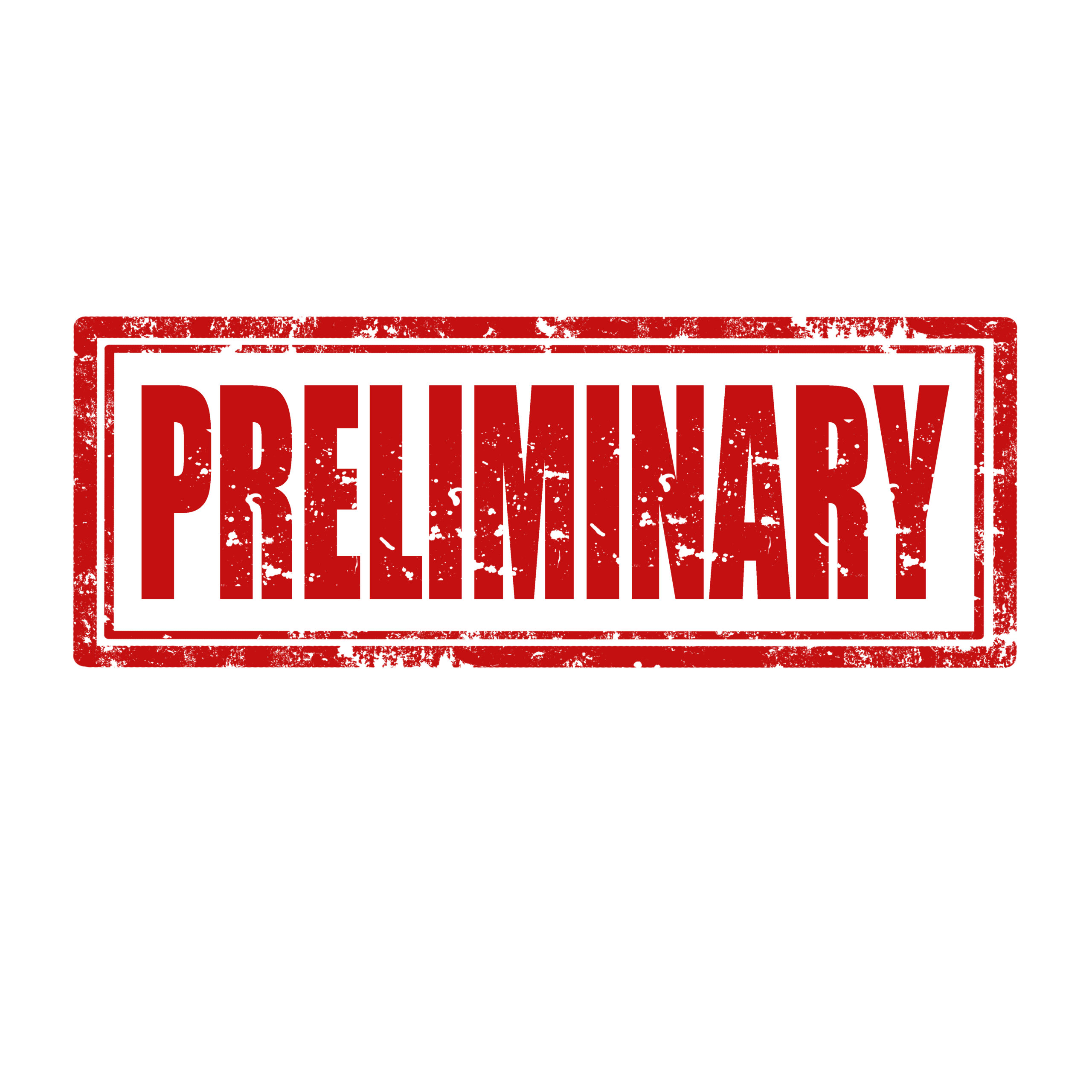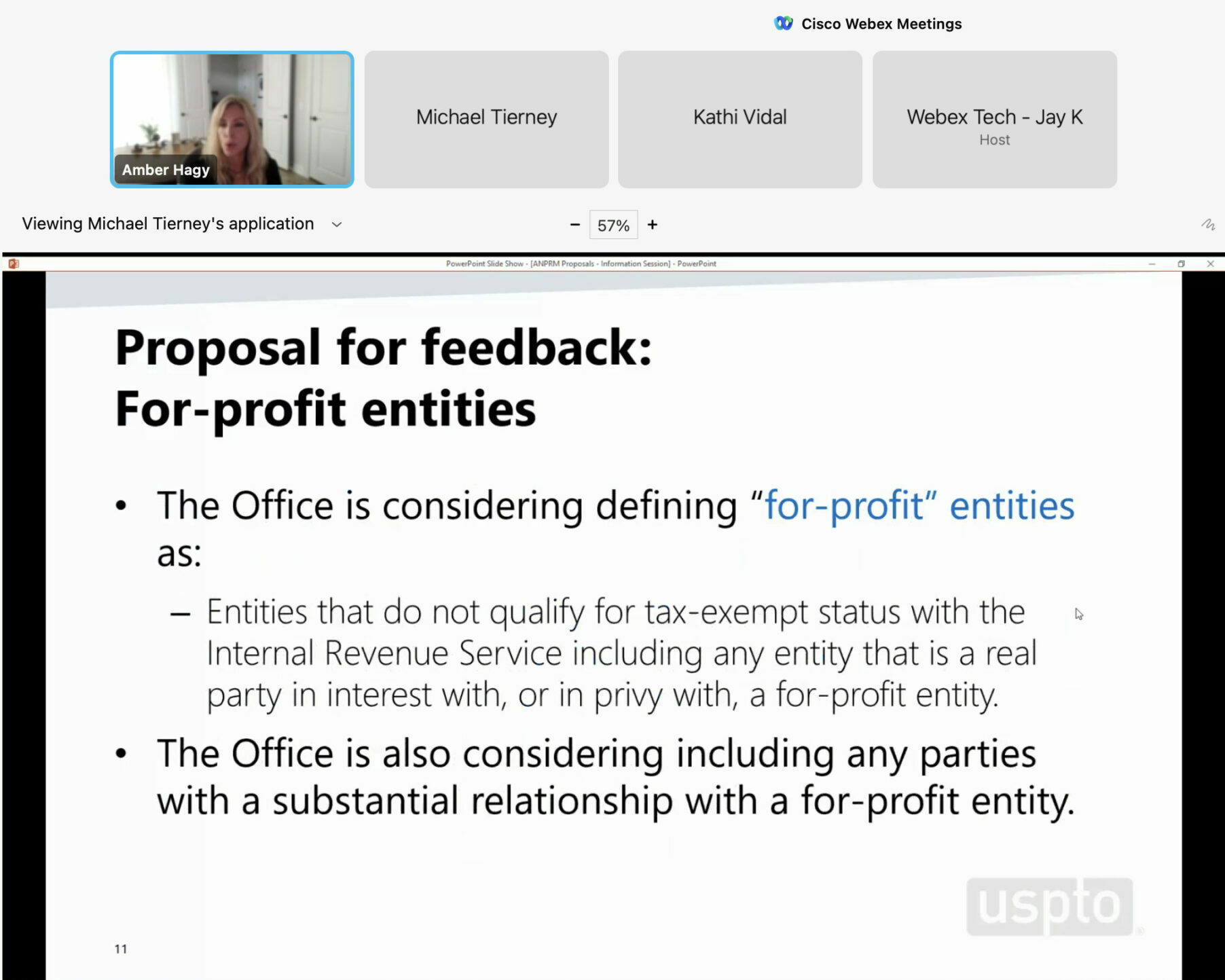“There’s nothing here that’s set in stone. We’re trying to align USPTO practices with congressional intent.” – Chief APJ Michael Tierney
 U.S. Patent and Trademark Office (USPTO) Director Kathi Vidal, Vice Chief Administrative Patent Judge (APJ) Michael Tierney of the Patent Trial and Appeal Board (PTAB) and Lead APJ Amber Hagy presented a webinar Tuesday on the Office’s Advance Notice of Proposed Rulemaking (ANPRM) on PTAB practices, walking attendees through some of the key proposals, and repeatedly reassuring stakeholders that the ANPRM does not contain any proposed rules.
U.S. Patent and Trademark Office (USPTO) Director Kathi Vidal, Vice Chief Administrative Patent Judge (APJ) Michael Tierney of the Patent Trial and Appeal Board (PTAB) and Lead APJ Amber Hagy presented a webinar Tuesday on the Office’s Advance Notice of Proposed Rulemaking (ANPRM) on PTAB practices, walking attendees through some of the key proposals, and repeatedly reassuring stakeholders that the ANPRM does not contain any proposed rules.
The widespread confusion about the ANPRM was highlighted during Vidal’s recent oversight hearing by the House IP Subcommittee. Vidal got down to basics Tuesday:
“The ANPRM is the precursor to what is called an NPRM. Most of what you’re probably seen from government, including from our Office, is us going directly to an NPRM. An NPRM usually takes feedback from the public and proposes specific rule language for you to comment on. Right now, any of the feedback you provide is going to help us shape those rules.”
Referencing a Department of Labor explanation about the use of ANPRMs, Vidal said that it is a tool employed when an agency needs more information or data to determine whether a particular rule is warranted. Tierney told attendees that the Office would welcome any data stakeholders can provide about the PTAB process as part of their submissions.
Vidal also once again reiterated that the Office will not be as flexible on the deadline of June 20 for comments on the ANPRM as it has been in the past on other requests for comments because it wants to push forward the proposed rules as soon as possible.
 Hagy explained that comments do not have to be limited by the proposals in the ANPRM and can include anything of interest to stakeholders. However, the two APJs highlighted some of the most discussed “proposed proposals,” including nailing down the definitions of terms like “substantial relationship” and “for-profit entities”; further elucidating the meaning of “compelling merits” as the standard for institution of an inter partes review (IPR) proceeding; and how to fairly implement a proposal that would allow parties to pay for additional briefing.
Hagy explained that comments do not have to be limited by the proposals in the ANPRM and can include anything of interest to stakeholders. However, the two APJs highlighted some of the most discussed “proposed proposals,” including nailing down the definitions of terms like “substantial relationship” and “for-profit entities”; further elucidating the meaning of “compelling merits” as the standard for institution of an inter partes review (IPR) proceeding; and how to fairly implement a proposal that would allow parties to pay for additional briefing.
One of the most controversial proposals in the ANPRM would call for discretionarily denying any IPR petition brought by a “for-profit entity.” The proposals include narrowing down what precisely would constitute a “for-profit entity” by determining whether the entity qualifies for tax exempt status with the IRS. If they do not, and have not been sued or threatened with infringement of the challenged patent, are not an entity practicing within the field of the patent with a product or service on the market, and don’t have any substantial relationship with an entity that falls outside the scope of elements 1-3, the Office is considering automatically denying the petition.
 The proposals also contemplate more consistent denials of petitions where there has been a prior, final adjudication in district court or a post grant proceeding that upheld the validity of the challenged claims, and where there’s an overlap between the claims finally adjudicated and those being challenged in the petition.
The proposals also contemplate more consistent denials of petitions where there has been a prior, final adjudication in district court or a post grant proceeding that upheld the validity of the challenged claims, and where there’s an overlap between the claims finally adjudicated and those being challenged in the petition.
Vidal on Tuesday urged everyone to read the ANPRM in its entirety, despite its length, characterizing statements that have been made on the rules, presumably in the press, as “not accurate.”
In total, there are seven key “proposed proposals” in the ANPRM, plus five additional categories of changes:
Seven Primary Proposals
1. Petitions filed by certain for-profit entities;
2. Petitions challenging under-resourced patent owner patents where the patentee has or is attempting to bring products to market;
3. Petitions challenging patent claims previously subject to a final adjudication upholding the patent claims against patentability challenges in district court or in post-grant proceedings before the USPTO;
4. Serial petitions;
5. Petitions raising previously addressed prior art or arguments (subject to the 35 U.S.C. 325(d) framework);
6. Parallel petitions; and
7. Petitions challenging patents subject to ongoing parallel litigation in district court.
Five Additional Proposed Changes
(1) absent exceptional circumstances, requiring petitioners to file a stipulation that neither they nor their privy or real parties have filed prior post-grant proceedings (PGRs, IPRs, CBMs or ex parte reexaminations) on the challenged claims; and that if their post-grant proceeding is instituted, neither they nor their privy or real parties in interest, will challenge any of the challenged claims in a subsequent post-grant proceeding (including PGRs, IPRs and ex parte reexamination);
(2) requiring petitioners to file a separate paper justifying multiple parallel petitions;
(3) allowing a potential payment of a fee to enhance the word-count limits for a petition to avoid multiple parallel petitions;
(4) providing for separate briefing on discretionary denial issues; and
(5) requiring filing of all settlement papers when the dismissal of AIA proceedings is sought, whether pre- or post-institution.
While the webinar on Tuesday walked attendees through the details of some of the above proposed changes, the Office did not accept questions and did not comment on substance, as Vidal has explained previously that neither she nor her staff will be commenting on the substance of the proposals throughout the rulemaking process and will let the written record speak for itself.
“There’s nothing here that’s set in stone,” Tierney said. “We’re trying to align USPTO practices with congressional intent.”
Comments on the ANPRM should be submitted at www.regulations.gov. To submit comments via the portal, enter docket number PTO–P–2020–0022 on the homepage and click “search.” The site will provide search results listing all documents associated with the docket; click on the “Comment” icon, complete the required fields, and enter or attach comments.

![[IPWatchdog Logo]](https://ipwatchdog.com/wp-content/themes/IPWatchdog%20-%202023/assets/images/temp/logo-small@2x.png)

![[Advertisement]](https://ipwatchdog.com/wp-content/uploads/2024/04/Patent-Litigation-Masters-2024-sidebar-early-bird-ends-Apr-21-last-chance-700x500-1.jpg)

![[Advertisement]](https://ipwatchdog.com/wp-content/uploads/2021/12/WEBINAR-336-x-280-px.png)
![[Advertisement]](https://ipwatchdog.com/wp-content/uploads/2021/12/2021-Patent-Practice-on-Demand-recorded-Feb-2021-336-x-280.jpg)
![[Advertisement]](https://ipwatchdog.com/wp-content/uploads/2021/12/Ad-4-The-Invent-Patent-System™.png)







Join the Discussion
No comments yet.